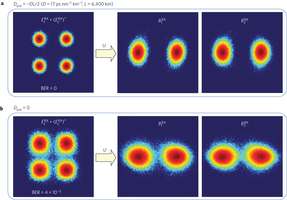May 27, 2013 report
Researchers discover a way to dramatically reduce distortion in long distance fiber cable

(Phys.org) —A team of researchers working at Bell Labs in New Jersey has found a way to dramatically reduce the amount of distortion in long distance fiber cables. Their method results, the team reports in their paper published in the journal Nature Photonics, in an ability to transmit more data over very long fiber cable lines.
Fiber cable is able to carry data faster than copper wire because it uses light as a medium, rather than electricity—light by its very nature has far less resistance. This feature allows fiber cables to carry far more data traffic than copper wire. Unfortunately, it also comes with a price. Because it uses light, fiber cable is adversely impacted by distortion. This necessitates the use of amplifiers and signal correctors on cables that traverse long distances—that can be a problem when the cable is laid under the ocean to connect continents such as Australia and Asia. In this new effort, the researchers report that they have found a way to overcome the problem of distortion for distances as long as 13,000 kilometers—while sending data at 400 gigabits per second. That's a rate the team says, that has long been thought impossible.
The researchers were able to achieve this feat by taking a completely new and ingenious approach to solving the problem of interference—they sent twin signals along the length of the cable that were completely offset from one another. When something interfered with one of the signals, the other was not impacted, thus it could compensate for the lost data when the twin waves were aligned at the receiving end by superimposing them over one another. The method allowed for a reduction in distortion by 8.5 dB.
Reducing distortion in long distance fiber cable lines won't necessarily make communications between the two sides any faster, but instead will allow for more traffic over the same cable. The new method would do away with the need for amplifiers and signal boosters as well, dramatically reducing the cost of laying and maintaining fiber cable, especially when it's sitting on the ocean floor. This is especially important for geographically isolated countries such as Australia which are seeing Internet traffic rise dramatically with no reasonable way to lay new fiber cable.
More information: Phase-conjugated twin waves for communication beyond the Kerr nonlinearity limit, Nature Photonics (2013) doi:10.1038/nphoton.2013.109
Abstract
Kerr nonlinearity imposes a limit on the achievable transmission performance and capacity of optical fibre communication links. We show that the nonlinear distortions of a pair of phase-conjugated twin waves are essentially anticorrelated, so cancellation of signal-to-signal nonlinear interactions can be achieved by coherently superimposing the twin waves at the end of the transmission line. We demonstrate that by applying this approach to fibre communication, nonlinear distortions can be reduced by >8.5 dB. In dispersive nonlinear transmission, the nonlinearity cancellation additionally requires a dispersion-symmetry condition that can be satisfied by appropriately predispersing the signals. By using these techniques we succeed in transmitting a 400 Gb s−1 superchannel over 12,800 km of fibre. We further show a connection between the nonlinearity cancellation and a nonlinear noise squeezing effect. The concept of using phase-conjugated twin waves to suppress nonlinear interactions may prove beneficial in other physical systems governed by the nonlinear Schrödinger equation.
Journal information: Nature Photonics
© 2013 Phys.org


















